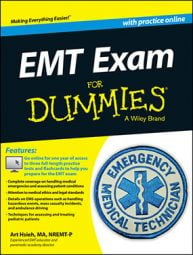This may not be what you immediately think of when you think EMS, but driving the ambulance will certainly be covered on the EMT exam. Perhaps the most dangerous part of an emergency incident is responding in the emergency mode.
Statistics show that your chances of being injured or killed while driving with lights and siren on is far greater than in your private vehicle or driving routinely. Part of the reason is that emergency vehicles such as ambulances are heavier and have higher centers of gravity than regular vehicles, making them difficult to handle at high speeds.
Additionally, modern vehicles are well insulated, which makes hearing a siren very difficult. Drivers can also be distracted given the level of technology being used in motor vehicles, such as cellphones. Drivers in other vehicles may react unpredictably when surprised by an emergency vehicle that “suddenly” appears in their rearview mirror.
These and other factors require you to drive with due regard for other drivers while operating your emergency vehicle. Driving with lights and siren on doesn’t give you authority over other drivers. In most states, the use of emergency lighting simply requires others to yield the right of way.
Many states still require you to adhere to the normal driving regulations, even in an emergency response. It simply makes sense to avoid acting crazily while responding to an emergency call. Your partner, your crew, and others driving around you will all appreciate it.
Here are a few guidelines for driving and parking an ambulance:
Before heading to the call, determine the best route to get there. Sometimes the shortest route isn’t the best one! Factor traffic and road conditions into your route planning.
Use your seat belt, both in the front and back of the ambulance. If you’re the driver, don’t be distracted by the radios, GPS, or computer terminals that are part of most ambulances today. Have your partner guide you to the call and operate the communications equipment so that you can focus on operating the vehicle.
If you’re the first to arrive at a vehicle crash, you may need to use your vehicle as a protective barrier to oncoming traffic. Turn the steering wheel so that if the ambulance is struck from behind, it will veer away from the incident scene, not into it.
If another emergency vehicle is on the scene by the time you arrive, park your ambulance so that you have more direct access to the patient compartment. Put on your reflective vest and very carefully depart the vehicle.
Some scene calls require you to size up homes, apartments, office buildings, and other commercial buildings to locate the best route of entry and exit. Sometimes the front door is not the best way! For example, hotels often have larger service elevators toward the rear of the building that make moving a gurney and equipment much easier.
If multiple vehicles are on-scene, park in such a way as to avoid being blocked by them. This may mean parking farther away than normal and walking into the scene with your gear. Hopefully, other responders on the scene will assist you when you’re ready to leave.
Driving patients to a hospital requires a smooth ride. Most ambulances are built on heavy-duty van or truck chassis, which are inherently stiff and uncomfortable for riders. Drive as if you have something delicate balanced on the gurney. Accelerate, turn, and brake slowly. Time traffic lights so that you don’t have to stop at every one. Choose routes that minimize stops, hazards, or rough road surfaces.
Very rarely do you need to drive patients to the hospital in emergency mode. The time you save is minimal, and whether it saves lives is unclear.

